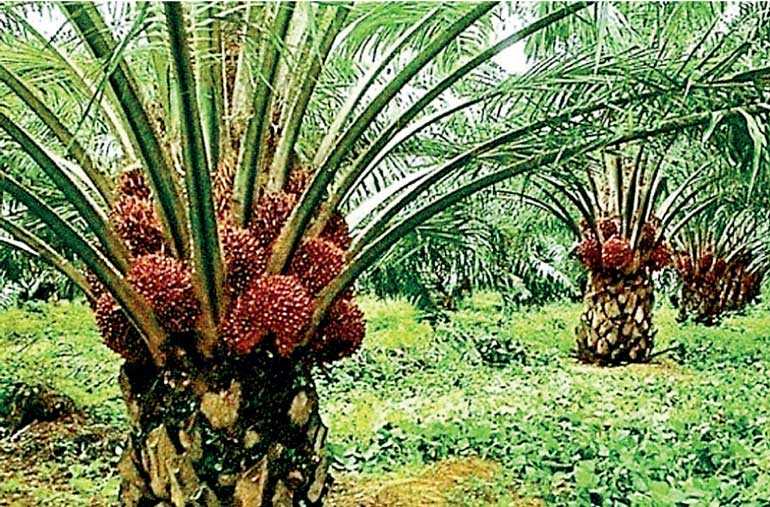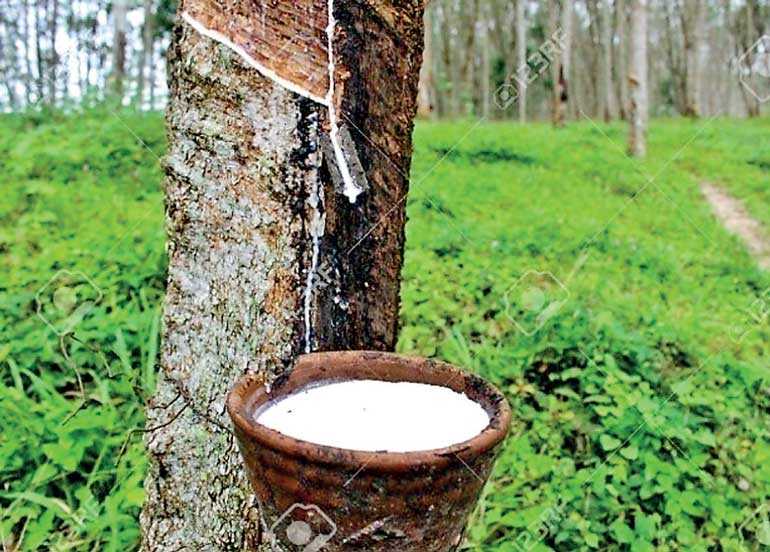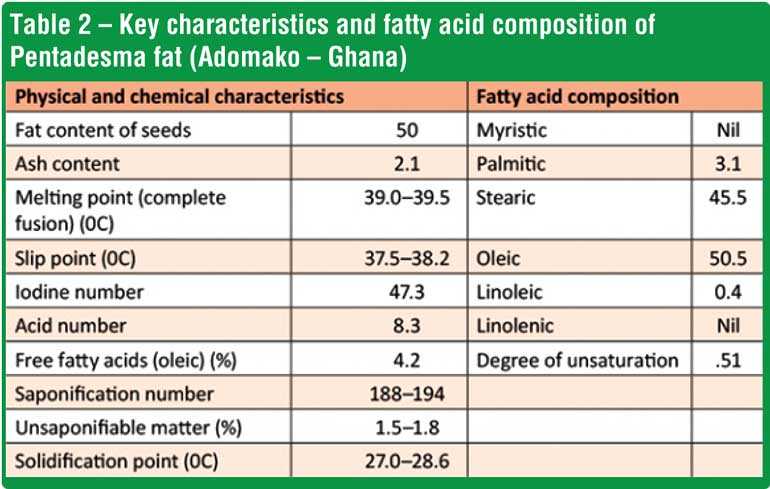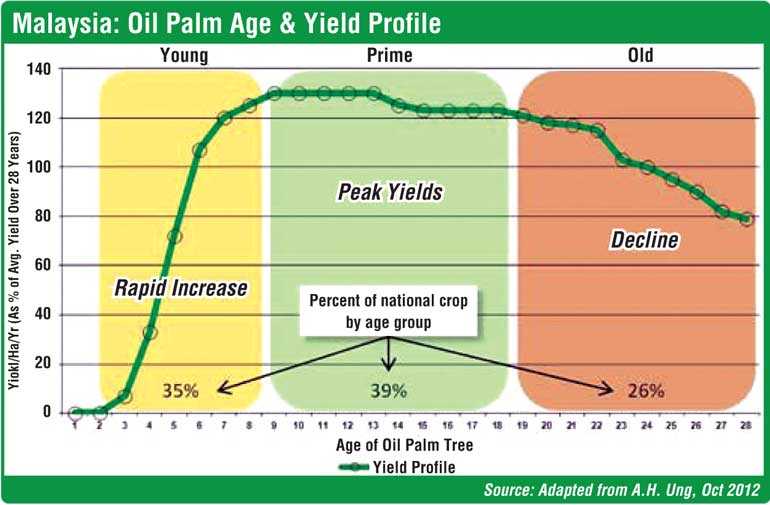Wednesday Feb 12, 2025
Wednesday Feb 12, 2025
Monday, 21 October 2019 00:00 - - {{hitsCtrl.values.hits}}

Oil palm trees produce up to 10 times more oil per hectare than any other crop, and global demand has more than doubled in the last 10 years

Rubber has made significant contribution to the GDP over 142 years of its existence in Sri Lanka

Vegan Cheese and Butter Cake using Pentadesma fat
by Hemal de Silva
Due to the low profits or losses from the two major plantation crops, tea and rubber, it is essential to find a perennial crop to diversify the uneconomical agricultural lands. Based mainly on the high productivity and profitability, the chosen and tested crop is oil palm (OP).
Another necessary requirement is the increased production of a vegetable oil to meet the local demand, as the production of coconut oil cannot be increased much further. However, the cultivation of OP for edible oil production has become a controversial topic. There are two groups for and against, debating over its benefits and adverse effects in the Sri Lankan context.
The Central Environmental Authority (CEA) has received many public complaints related to OP cultivation, which have increased due to the escalating trend in converting rubber plantations into OP. However, the CEA was unable to find justifiable reasons in this regard.
Therefore, the CEA-appointed a committee consisting of the main stakeholders: Ministry of Plantation Industries (MPI), Coconut Research Institute of Sri Lanka (CRISL), Rubber Research Institute of Sri Lanka (RRISL), National Institute of Plantation Management (NIPM), University of Peradeniya Faculty of Agriculture, Ministry of Mahaweli Development and Environment, and the CEA, in order to find a suitable answer for public concerns.

For extending oil palm cultivation
Ministry of Plantation Industries (‘A Study to Identify Environmental and Social Issues of Oil Palm Cultivation in Sri Lanka’): “Since 1967, OP is used only to produce oil in Sri Lanka. To produce the required additional 80,000 MT of vegetable oil around 80,000 ha of coconut will be needed while OP needs only 20,000 ha, due to the crop’s high productivity. The cost of production (cop) of OP is very low compared to that of coconut.”
Report of the Coconut Research Institute of Sri Lanka (‘A Study to Identify Environmental and Social Issues of Oil Palm Cultivation in Sri Lanka’): “Expansion of OP cultivation in Sri Lanka has raised serious concerns about its environmental and social impact. These are: a) depletion of water sources b) indiscriminate disposal of oil palm fronds, empty fruit bunches and mill effluents c) loss of job opportunities and other social benefits to neighbouring villages of OP plantations which were under rubber. However, the CRISL observes that these issues have not been scientifically validated, and cultivation of OP should be carried out in a more scientific manner, minimising impact on the environment and society, while strongly approving diversification of lands in the RPCs without any damage to the environment, society and crops such as tea, rubber or coconut.”
Prof. Asoka Nugawela (‘Sustainable oil palm central to success of Sri Lanka’s plantation industry’, 28/11/2017): “Due to the versatility of palm oil, it has rapidly become the world’s most widely-used vegetable oil. Small nations like Sri Lanka have an unprecedented opportunity to offer sustainably-cultivated oil palm to make substantial positive contributions to the environment, and advance socioeconomic development on a scale never before witnessed in the country. It is Sri Lanka’s most profitable crop and generates Rs. 514,000 per ha/y (2015), way ahead of the profits of the other three major plantation crops added together.” Dr. Parakrama Waidyanatha (‘Oil palm cultivation and related issues’, 11/07/2019): “The main objection to cultivating OP is its purported excessive consumption of water, leading to the drying of wells and streams, which is not uncommon even in the wet zone where OP is not cultivated. Out of 15 observations in the CEA report, the majority are baseless. Excessive use of pesticides and fertilisers in OP compared to rubber is no greater than with other plantation crops, while much of the carbonic waste is used for generating energy, and effluent disposal with pollution risk is no greater than with rubber. Sri Lanka’s rubber growers are gradually abandoning rubber for alternative crops due to low productivity, skilled labour shortage, low prices, and profits. One answer to increasing greater profits from their lands is to grow OP.”
The fat composition of palm oil (not palm kernel oil) can be called heart-friendly, as it has 48.5% unsaturated fats, which decrease cholesterol and 38% monounsaturated fat, which is known to increase the good (HDL) cholesterol.
Sophia Rasheeqa Ismail, Siti Khuzaimah Maarof, Syazwani Siedar Ali and Azizan Ali, Malaysia (‘Systematic review of palm oil consumption and the risk of cardiovascular disease’)1: “Background: The high amount of saturated fatty acids (SFA) coupled with the rising availability and consumption of palm oil have led to the assumption that palm oil contributes to the increased prevalence of cardiovascular diseases worldwide. We aimed at systematically synthesising the association of palm oil consumption with cardiovascular disease risk and cardiovascular disease-specific mortality.
“Conclusion: in view of the abundance of palm oil in the market, quantifying its true association with CVD outcomes is challenging. The present review could not establish strong evidence for or against palm oil consumption relating to cardiovascular disease risk and cardiovascular disease-specific mortality. Further studies are needed to establish the association of palm oil with CVD. A healthy overall diet should still be prioritised for good cardiometabolic health.”
Against extending oil palm cultivation
Report of the Rubber Research Institute of Sri Lanka (‘A Study to Identify Environmental and Social Issues of Oil Palm Cultivation in Sri Lanka’): “Considering the large number of people who depend on the rubber industry directly and indirectly, its significant contribution to the GDP over 142 years of its existence in Sri Lanka, contributing to the ever-depleting forest cover from rubber plantations, RRISL highlights the following facts:
“Sri Lanka needs the rubber industry for environmental, social, and economical benefits. With 500 rubber trees/ha it uses 1/4th the fertiliser/ha of OP. The majority of the 9,413 ha of OP cultivation in the country is diversified from rubber. Diversification of rubber lands should be stopped, as further reduction will negatively affect the rubber industry altogether. There is a minimum rubber production required by the local industries, or otherwise they will have to move out to other countries where the rubber production is high. Productivity improvement is the responsibility of all. Neglected and poorly managed rubber fields should not be used for comparison with well-managed OP fields. At present, OP industry is blessed with an import tax of Rs. 135.00 per kilogram, and if this is to support the coconut growers, the policymakers should impose a better mechanism to support them, rather than sacrificing the environmentally-friendly rubber industry. Imposing regulations for the expansion of OP cultivation will only be a written remedy, as is evident by the violations made already, such as damaging catchment areas and ineffective effluent treatment plants.”
Dr. Gamini Hitinayake (‘A Study to Identify Environmental and Social Issues of Oil Palm Cultivation in Sri Lanka’): “A review done by the SLAAS in 2002 with the participation of scientists from CRI and RRI and also from other institutes as the resources persons (including Dr. Parakrama Waidyanatha, Dr. Jayantha Gunathilake, Dr. Thilakaratne, Dr. CR Panabokke) revealed the following about oil palm plantations when compared to rubber plantations (Balasuriya, 2002).”
Dr. Then Kek Hoe, Felda Global Ventures, Research and Development (Personal communication): “Felda Global Ventures, the third-largest oil palm estate operator in the world, is planning to diversify part of their 450,000 ha OP plantations to coconut because:
a)Coconut is more profitable than OP as yields are becoming low with successive rotations.
b)Labour requirement is less with coconut.
c)Coconut is disease-free; Ganoderma Basal Stem Rot (BSR) is fast becoming a major threat to OP cultivation for which there is no effective treatment. Ganoderma fungus is reported in some coconut plantations in Sri Lanka. According to Malaysian sources, coconut is more resistant to Ganoderma when compared to oil palm.”
Bangor University Senior Lecturer in Environmental Geography Dr. Simon Willcox, and University of Hull Post-doctoral Research Associate Dr. Adham Ashton-Butt (‘Replanting oil palm may be driving a second wave of biodiversity loss’, 10/05/2019): “What many people may not know, however, is that oil palm trees – the fruit of which is used to create palm oil – have a limited commercial lifespan of 25 years. Once this period has ended, the plantation is cut down and replanted, as older trees start to become less productive, and are difficult to harvest. Our research has now found that this replanting might be causing a second wave of biodiversity loss, further damaging the environment where these plantations have been created.
“An often overlooked fact is that oil palm plantations actually have higher levels of biodiversity compared to some other crops. More species of forest butterflies would be lost if a forest were converted to a rubber plantation, than if it were converted to oil palm, for example. One reason for this is that oil palm plantations provide a habitat that is more similar to tropical forest than other forms of agriculture (such as soybean production). The vegetation growing beneath the oil palm canopy (called understory vegetation) also provides food and a habitat for many different species, allowing them to thrive. Lizard abundance typically increases when primary forests are converted to oil palm, for example.”2

Alternate solution
It is necessary for Sri Lanka to increase the production of vegetable oil to supply the deficit of 80,000 MT/y for local consumption. Due to low yields and shortage of suitable land for growing coconut, a decision has been taken to grow OP in 20,000 ha to produce this deficit. The main benefits from OP are the high productivity and the resulting low cost. RPCs expect high profits by growing OP, and at the same time reduce losses from uneconomical tea and rubber plantations.
A vegetable oil should preferably give the consumer (1) nutritive and health benefits (2) a commodity at a low cop and labour requirement (3) versatile commodity (4) with least adverse effects on environment and (5) high ROI to grower. Whether such a “perfect” commodity exists is another question. However, consider the species, Pentadesma butyracea (African Butter Tree), that has been in the Royal Botanic Garden, Peradeniya since 1897, one that will give more benefits to humanity, environment and to Sri Lanka ultimately, than oil palm (Elaeis guineensis).
A brief introduction
P. butyracea is an evergreen and perennial tree crop suitable for growing in tropical and subtropical regions. It is found in the forests in many countries in the West African Region. Pentadesma will produce an edible fruit with oil rich seeds for well over a century ultimately yielding good quality timber.
The 122 year old tree in the Royal Botanic Garden, Peradeniya continues to produce a substantial crop of fruits at least annually. Another tree 25 years old is in the Garden. This species is likely to be productive for 150 to 200 years though it has not been domesticated so far.
Taking seeds from the now 122-year old tree, a small plantation was established in Kahawatta in 2009 and reached maturity in 2017. As requested by the former Director and former Head, Plant Science Department of the RRISL arrangements were made for collection of seeds from Peradeniya in 2012 and understand 600 to 700 seedlings had been raised for planting.
Pentadesma fat is a substitute for cocoa butter. Cocoa butter is the healthiest and costliest vegetable fat. Shea (Africa), Illipe (Indonesia), Kokum, Sal and Mango seed kernel butters (India) are substitutes for cocoa butter. Cocoa is a plantation crop while the others are “Exotic” butters as its production is from seeds collected from forests. Pentadesma can be cultivated as a plantation tree crop either on a small or large scale. The specifications of Pentadesma butter are given below.
(1)Nutritive and Health Benefits: The concentration of stearic acid is 45%. To quote Prof. V.K.S. Shukla, “Pentadesma is a natural-borne tree fat and totally devoid of unwanted material. Long chain fatty acid such as stearic is the most desirable for human health. This is the reason for cocoa butter which contains the highest concentration of stearic acid help centurions who consume cocoa improve their health dramatically. Further, low linoleic acid and using the fat for producing trans-fat free foods will reduce and prevent CVDs. Above facts speaks for itself and confirms the superiority of Pentadesma fat for human health. ”
(2)Commodity at a Low COP and Labour Requirement: Oil Palm has a life span of 30 years, reaching maturity in 2 – 3 years, yields increasing rapidly by the 8th and start declining by the 20th year, making it necessary to replant after 30 years. The inputs are not as low as Coconut (“The lazy man’s crop”) but the low cop is mainly due to the high productivity.
Pentadesma has a life span of perhaps 150 to 200 years. In Sri Lanka, Seychelles and Singapore there are trees over 100 years old. The 122-year-old tree in Sri Lanka continues to produce a substantial crop of fruits at least annually. In 2013/14 two crops were produced within 16 months. A disadvantage of P. butyracea is the immature period of eight years and the low yields for a number of years but, this will be more than compensated with a long lifespan giving multiple benefits to several generations of Sri Lankans.
Accurate information on yields can be obtained from the 122 and 25-year-old trees in the Botanic Garden. The small plantation in Kahawatta with about 340 trees that reached maturity in 2017 will provide yield records in the early years. What has not been taken into account is the large volume of an edible fruit available each year.
(3)Versatility: If produced, Pentadesma butter as a substitute for cocoa butter will be in demand in cosmetics, food and confectionery industries. The extraction of the butter is a much simpler process than palm oil. With the mid fraction of palm oil, a cocoa butter equivalent can be formulated for producing high quality chocolates without any cocoa butter.
Pentadesma butter has a higher content of Oleic acid and can be used to produce biodiesel at a lower cost than from palm oil. This fat is a far more versatile commodity, with a lower cop than po and would have been a much sought-after vegetable fat if it had been produced in humid and other regions where even OP cannot be grown. Pentadesma fat can be produced in tropical and subtropical regions. Introduced in 1950s, it has grown successfully and produce fruits in Yunnan and Fujian provinces in China.
(4)Adverse effects on environment: With a long life span of perhaps 150 to 200 years, as the trees grow it will be necessary to thin out interfering ones. If rubber is an answer to depleting forest cover and OP has good biodiversity compared to other oil producing crops, there is no doubt Pentadesma will be a more suitable species for the same reasons than rubber or oil palm. As in rubber and OP, the necessity to cut down all the trees at the same time for replanting need not arise. Waste products such as the pressed cake after extracting the fat and the exocarp of the fruit may be useful to be converted into at least compost.
(5)High ROI to Grower: Seeds or tissue-cultured plants can be produced in Sri Lanka. Management of 400 seedlings per ha, keeping the weeds in inter rows under control or growing a leguminous cover, application of fertiliser, collecting the self-harvesting fruits during 3- 4 months annually and extracting the vegetable fat will need a lower requirement of labour and other inputs compared to OP. Depending on the yield per ha and the selling price per kg of Pentadesma fat, the ROI will be much higher than from oil palm, tea, rubber or coconut. Despite the disadvantage of late maturity of Pentadesma it will give humanity and the environment multiple benefits in the long term, which none of the others can give.
Conclusion
In Sri Lanka, oil palm has and will be grown not by deforesting forests but in agricultural land presently under uneconomical tea and rubber. The main attraction of OP is the quick and high returns from the crop. The experience of Felda Global Ventures is valuable as they reflect their wide experience with the crop in Malaysia. We in Sri Lanka are well aware of the adverse effects of climate change and will not be able to do anything tangible to reverse the situation in the world. However, we too can do something useful not to make the situation worse. That I believe is by at least increasing the population of perennial trees where possible. A perennial tree that will be productive and provide economical benefits and a commodity that can improve the health of Sri Lankans would really be our objective, bearing in mind the future generations.
(The writer can be reached via [email protected].)
Footnotes:
1https://journals.plos.org/plosone/article?id=10.1371/journal.pone.0193533
2Based on research carried out in industrial oil palm plantation located in the Siak regency of Riau province, Sumatra, Indonesia [0°55'56"N, 101°11'62"E]
Discover Kapruka, the leading online shopping platform in Sri Lanka, where you can conveniently send Gifts and Flowers to your loved ones for any event including Valentine ’s Day. Explore a wide range of popular Shopping Categories on Kapruka, including Toys, Groceries, Electronics, Birthday Cakes, Fruits, Chocolates, Flower Bouquets, Clothing, Watches, Lingerie, Gift Sets and Jewellery. Also if you’re interested in selling with Kapruka, Partner Central by Kapruka is the best solution to start with. Moreover, through Kapruka Global Shop, you can also enjoy the convenience of purchasing products from renowned platforms like Amazon and eBay and have them delivered to Sri Lanka.
Discover Kapruka, the leading online shopping platform in Sri Lanka, where you can conveniently send Gifts and Flowers to your loved ones for any event including Valentine ’s Day. Explore a wide range of popular Shopping Categories on Kapruka, including Toys, Groceries, Electronics, Birthday Cakes, Fruits, Chocolates, Flower Bouquets, Clothing, Watches, Lingerie, Gift Sets and Jewellery. Also if you’re interested in selling with Kapruka, Partner Central by Kapruka is the best solution to start with. Moreover, through Kapruka Global Shop, you can also enjoy the convenience of purchasing products from renowned platforms like Amazon and eBay and have them delivered to Sri Lanka.